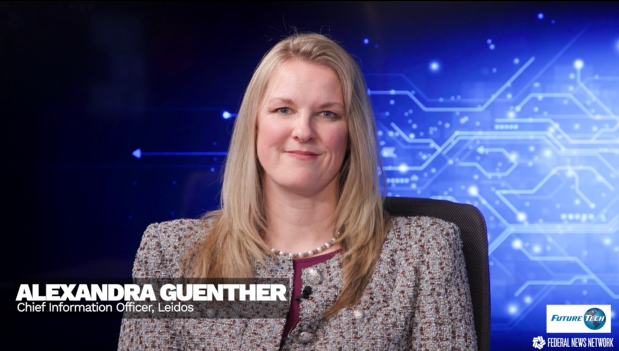This is the seventh article in our IT lifecycle management series, Delivering the tech that delivers for government.
How can an organization the size of Leidos — with nearly 50,000 employees worldwide — take advantage of disruptive technologies to help its staff work at its best and its business mature digitally?
For starters, it’s by not focusing all eyes, minds and efforts forward, said Alexandra Guenther, senior vice president and chief information officer at Leidos. It requires what she called a forward-back methodology that accounts for both future and past technological developments and practices, she shared with Federal News Network for our series Delivering the tech that delivers for government.
“We’re able to look forward to where we need to go with our technologies, but then also look … from an outcome perspective, and then march backward and see where gaps are,” Guenther explained. “That’s where we really start looking at: Where do we want to and need to make investments? Where do we want to partner more effectively? And, where can disruptive technology not be disruptive, but actually be the missing puzzle piece?”
Taking on the tough questions
Throughout the wide-ranging conversation, Guenther shared how she as CIO is taking that approach but also how Leidos teams are doing so and how that helps it innovate while also delivering on demands from its federal government partners.
This approach let the company tease out more than three dozen use cases, which Guenther described as “basically business questions that we had a hard time answering natively using the technology at hand, without applying really high-end data analytics and AI-enabled data analytics.”
Leidos now has a roadmap, and it’s tackling those tough questions year over year and applying them directly to how its teams deliver services to customers, she said.
“It’s allowing us to deliver faster and more accurately by looking at: What are the capabilities we’re trying to get to? What hard problems can’t we solve?” Guenther said. “And, if we think about them differently and apply some of these disruptive technologies, such as AI, we can get to those results and sometimes get to them sooner.”
Nothing is discrete in technology
While Leidos applies this forward-backward approach to identify potential gaps that could impact how it should continue to evolve, one thing Guenther made clear is that no technology can exist in a silo. Integration across technologies, across frameworks, across disciplines is essential to make progress and ensure innovation.
“This idea of everything integrating and all the piece parts coming together in systems of systems to achieve outcomes is very much my frame of reference for a lot of the work that I’ve done in my career,” she said.
That certainly didn’t change when she stepped into her role as CIO in March 2024, after nearly 20 years at Leidos and being directly involved in many projects supporting the government.
Guenther pointed to the need to think holistically and act based on overarching potential while also accounting for risk tolerance. “We’ve got supply chain risk, and we’ve got CMMC risk, and we’ve got zero trust, and each one of them have a framework — and then AI governance, right? Each one of them have their own frameworks that we’re using to govern them, but they really sing when you tie them all together.”
Because all of these items take place across years, her team must also account for the regulatory compliance factors too. “What’s the why behind it? What’s the risk tolerance of our corporation? And then how far past compliance do we need to go?” she said. “Sometimes compliance is fine for our risk tolerance, and sometimes we have to go much further.”
Beyond the obvious with AI
When it comes to taking advantage of AI, people often focus on accessing and analyzing data, but Leidos has tapped into how to capitalize on AI to visualize data as a way to empower its workforce. It’s that piece that pushes the technology and its ability help drive change out from the technology hub and into the hands of people on the frontlines, Guenther said.
She shared that Leidos partnered with Moveworks to launch an employee productivity AI-driven chatbot, for example.
“We have an ability to scale our workforce in a way and to put productivity in the hands of our workforce that is so empowering for all of them, nearly 50,000 people across the globe,” Guenther said.
But that’s just one piece, she said. “The other piece is on the enterprise business side, looking at how we are storing, analyzing and visualizing our data from how we do business as a business. That’s where we’re really seeing the scaling of analysis, processing and the ability to assess data in a much different way — delivering data faster, delivering results faster to our federal customers or commercial customers, as well as to our management team, so we can make decisions faster.”
Helping government think differently
Applying this approach and also battle-testing new technologies within its own business helps Leidos when it works with its government partners too, Guenther pointed out.
“The government is in a space where they are seeking to do things differently,” she said.
It’s what makes her passionate and excited about her CIO role. “Are we willing to and are we excited about and are we invested in looking at things differently and helping our customers see it through that same lens, so they can feel that same energy?”
Guenther said the answer is a full-throated yes. “In technology, sometimes you just need to live through some of those deployments, live through some of those models and understand what works and what doesn’t work and what levers you have to pull.”
Discover more stories about how federal systems integrators and government contractors manage their enterprise infrastructure environments in our series Delivering the tech that delivers for government, sponsored by Future Tech Enterprise.
To listen to the full discussion between Leidos’ Alexandra Guenther and Federal News Network’s Vanessa Roberts, click the podcast play button below:
Check out all podcast episodes of the Delivering the tech that delivers for government series.
Copyright
© 2025 Federal News Network. All rights reserved. This website is not intended for users located within the European Economic Area.







